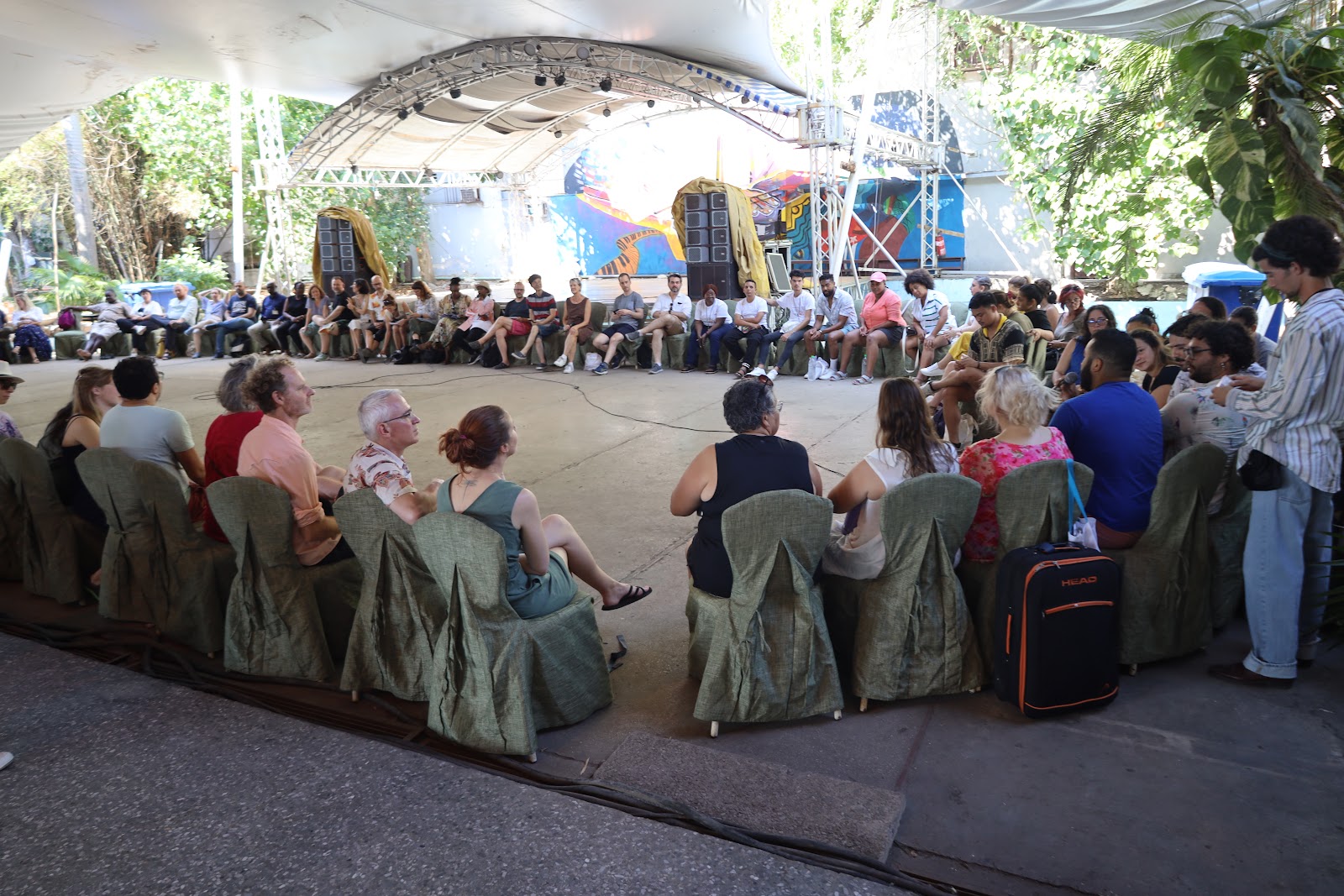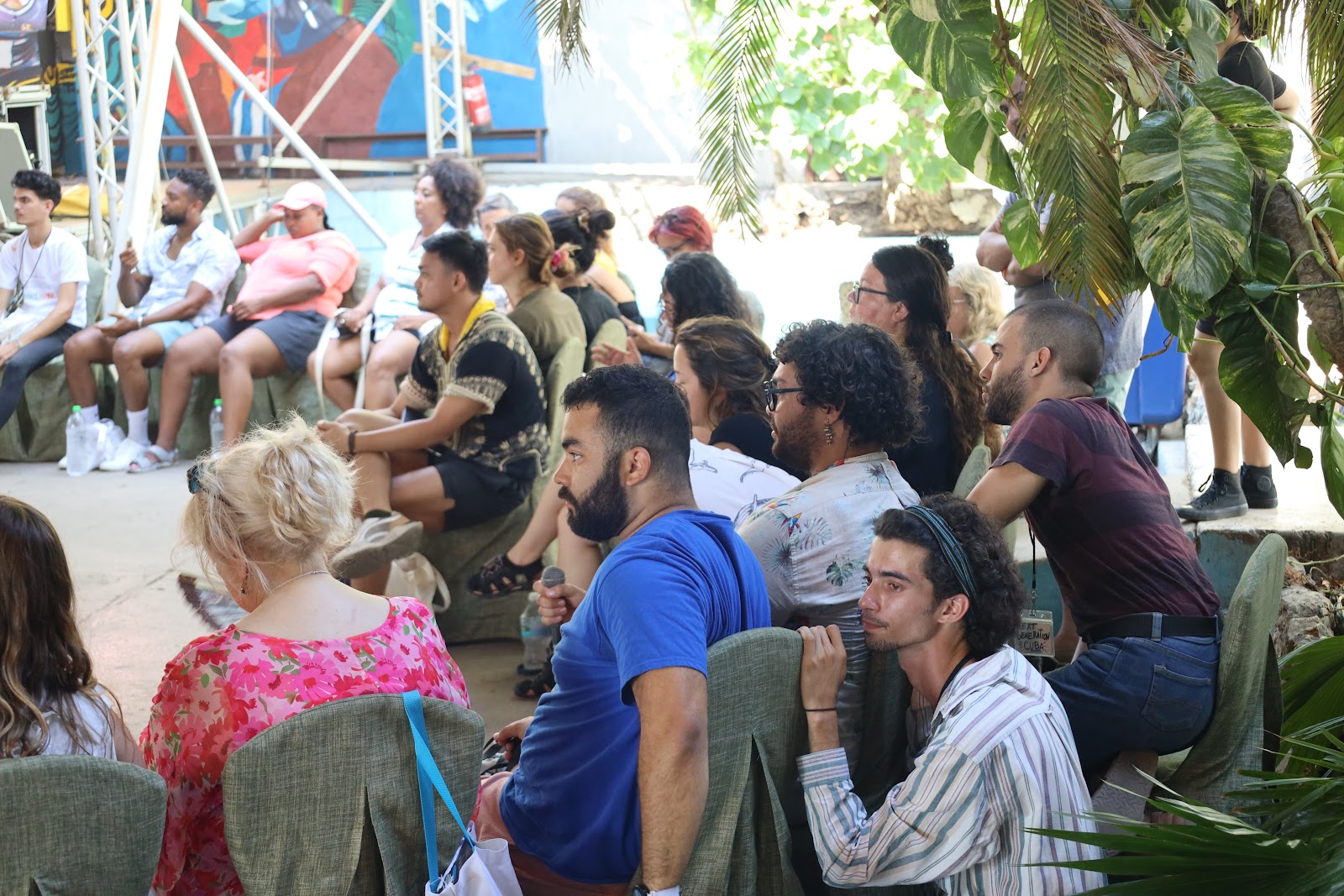Tuesday, June 18, 2024
Assitej Awards for people from UK - Lifetime Achievement Award for Vicky Ireland & Emerging Scholars Award for Dr. Kitty Morley
Saturday, June 8, 2024
Entendemos La Historie, Esta es La Revolución - Understand History, This is the Revolution
A word about Cuba the country... So much complexity around the economy, the government currency rates, the pesos for dollars on the streets... power cuts... some notes here to help find a way through.
Why does the US have Guantanamo? It was 100 yr lease for 1902 when the US helped to fight the Spanish.
My airbnb host told his story of the revolution. 1953 and Castro's fight against Batista and subsequent capture and trial where he defended himself...'History will observe me.' His exile.
His return in 1956 in a boat with just 82 men. And his fight from the East to the West of the island between 1956 to 1959.
Until December 1958 when Batista flees to the Dominican Republic with 300 million dollars.
The Bay of Pigs 16th-19th April 1961. And cuban missile crisis in 1963, when Castro was unhappy that Kruschev did a deal with Kennedy.
He told me about the The film I am Cuba. It is a proud history. However, it now seems it may be in the way of the best interests of the people, when some struggle receive basic supplies.To Hell with Paradise - Batida Theatre, Denmark
The show takes place outside, under a metal roof, in case of rain. Bated are experienced at playing in Cuba & they have brought their own generator in case of power cuts.
The Festival goers arrive on a bus & are greeted with much excitement by the group of local children. However once the actors descend from their bus, the excitement doubles and the show begins. The serpent enters, and there is Adam and Juliet and an apple.
Each scene has captions in Spanish and is separated by a musical number from a Rock Band. The mix of Shakespeare and Genesis temptation story unfolds. There is a moment of death & tragedy when Juliet's pregnancy is discovered.
However the magic of theatre steps in via the Serpent, who explains that Juliet's pregnant stomach is 'only a balloon'. And the star-crossed lovers are given a ticket to Freedom
Friday, June 7, 2024
Kopergierty - a theatre for young people in Belgium - Culture Is Not Only Inherited From The Past, But Also Borrowed From Next Generations!
The overall emphasis is on working with contemporary artists, and to attend to the new developments of a rapidly changing society - and to the need for children to access new technology.
This is alongside the need for well-being, education, playful chaos and a sense of belonging.
The Value of Theatre for Young People - Can we discuss the value of the Art? Or are we stuck with secondary outcomes of Education, Health and Social?
What was most surprising was to attend a seminar on the value of theatre for young people and to find that none of the value measurements included the aesthetic value. This is ASSITEJ's 'Building Collective Resilience' strand of work, a part of which aims to bring together published academic papers as well as evaluation reports (so called 'grey papers' written by practitioners and theatre companies but not peer reviewed) to build a bank of evidence for the value of theatre for young people. Evidence needs to include an element of self-reporting by children. Whilst it is not surprising that this includes aggregating evidence in terms of sectors such as education, health and social, what is surprising is that there is no acknowledgement of the aesthetic value.
ASSITEJ CUBA - We need new voices for a new world; let us make them heard!
The 21st ASSITEJ World Congress & Performing Arts Festival for Children & Young People
Entitled Voices of a New World, the event took place in Havana, Cuba from 24th May to 1st June 2024
1000+ Artists from 70+ Countries • 65 Workshops, Talks & Discussions • 25 Performances from 5 Continents
A key challenge was to make space for the next generation voices to be heard
Thursday, June 6, 2024
Co-creation internationally - Children are the same all over the world - As crianças são as mesmas em todo o mundo
I give a specific example of the artistic process.
I give some detail of how we make the project.
- We work in a region called Fenland, where there is very little cultural provision, but there is a museum
- We work in partnership with the museum
- Take objects from a local museum to schools
Patrimonio/Museos
Doy un ejemplo concreto del proceso artístico.
Doy algunos detalles de cómo realizamos el proyecto.
- Trabajamos en una región llamada Fenland, donde hay muy poca oferta cultural, pero hay un museo
- Trabajamos en colaboración con el museo
- Llevamos objetos del museo local a las escuelas
- Make a map of the local area, a co-created map
- Children write stories inspired by these objects.
- And for this process we create a space of quiet when the children can write uninterrupted for about 20 minutes.
- Hacer un mapa de la zona, un mapa creado conjuntamente.
- Los niños escriben historias inspiradas en estos objetos.
- Y para este proceso creamos un espacio de tranquilidad en el que los niños pueden escribir sin interrupciones durante unos 20 minutos.
- We say that every story will be read by us the artists
- We give special paper and pens and a freedom to write whatever they want.
- Decimos que cada historia será leída por nosotros, los artistas.
- Les damos papel y bolígrafos especiales y libertad para escribir lo que quieran.
- We sometimes give a frame – and use a limitation as a stimulation.
- A story which involves the object, the location…
- A story where something happens, where characters change/transform
- A story that may have action, horror, comedy, romance, adventure…
- A mix of fact and fiction – and there are different ways into a story – for example - I ask the children to include 2 truths and a lie – some things that happened but something that you have imagined.
- A veces damos un marco y utilizamos una limitación como estímulo.
- Una historia en la que interviene el objeto, el lugar...
- Una historia en la que ocurre algo, en la que los personajes cambian/se transforman
- Una historia que puede tener acción, terror, comedia, romance, aventura...
- Una mezcla de realidad y ficción - y hay diferentes maneras de escribir una historia - por ejemplo - les pido a los niños que incluyan 2 verdades y una mentira - algunas cosas que sucedieron pero algo que han imaginado.
- If they can’t write, we can support and ask them to tell us a story and we will write
- If they can’t think of a story I might say, I am thinking of a story can you guess what it is.
- Always a child will find a story
- Si no saben escribir, podemos ayudarles y pedirles que nos cuenten una historia y nosotros escribiremos.
- Si no pueden pensar en una historia, puedo decirles: "Estoy pensando en una historia, ¿adivinas cuál es?
- El niño siempre encontrará una historia
- It is important that the child has the authentic creative process, to experience how to make something from nothing – and this is what is special – seeing the children enjoy this - for 20 mins you can feel in the room the silence and the noise of young imaginations at work
- Es importante que el niño viva el auténtico proceso creativo, que experimente cómo hacer algo de la nada, y esto es lo especial, ver a los niños disfrutar de ello: durante 20 minutos puedes sentir en la sala el silencio y el ruido de la imaginación de los más pequeños trabajando.
- The show works because the stories are from the children, telling of stories we could not imagine, and because it has been co-created with historical objects and tells a story of a landscape which has not been told.
- El espectáculo es maravilloso porque los relatos proceden de los niños, cuentan historias que no podríamos imaginar, y porque se ha creado conjuntamente con objetos históricos y cuenta la historia de un paisaje que no se ha contado.
One teachers said to me… “the children must take ownership of their history, it is their past, they own it and they must draw upon it to shape the future going forward.”
Uno de los profesores me dijo... "los niños deben apropiarse de su historia, es su pasado, les pertenece y deben basarse en él para dar forma al futuro que les espera."
Tuesday, June 4, 2024
ASSITEJ FESTIVAL HAVANA - How do we listen to and create with children?
Some notes from a talk at Casa Simon Bolivar, Old Havana
I shared a platform with Teresa Rotemberg from Argentina/Switzerland. We had different disciplines, Teresa - dance/movement, myself - stories/theatre. I spoke about co-creation as a producer and as an artist in terms of work with and for children.
As a producer, this involves collaborating with other non-artistic sectors, like council, health and education. The benefit of this is to be able to create work with other sector budgets, and to be able to expand the influence of the work so more children are listened to by more people.
Education has a different function to art, but it is useful to quote Paulo Freire to demonstrate education's qualities of transformation.
“Education either functions as an instrument which is used to facilitate integration of the younger generation into the logic of the present system and bring about conformity OR it becomes the practice of freedom, the means by which men and women deal critically and creatively with reality and discover how to participate in the transformation of their world.”
In producing work with non-artistic partners, it was important to set the best artistic context for the children to create with the key artistic impulse being story. Children are given the opportunity to write their own story, because if they don't someone else will. It is important for children to feel the power and agency to imagine something different... and with the possibility for imagining comes the possibility of change.
























